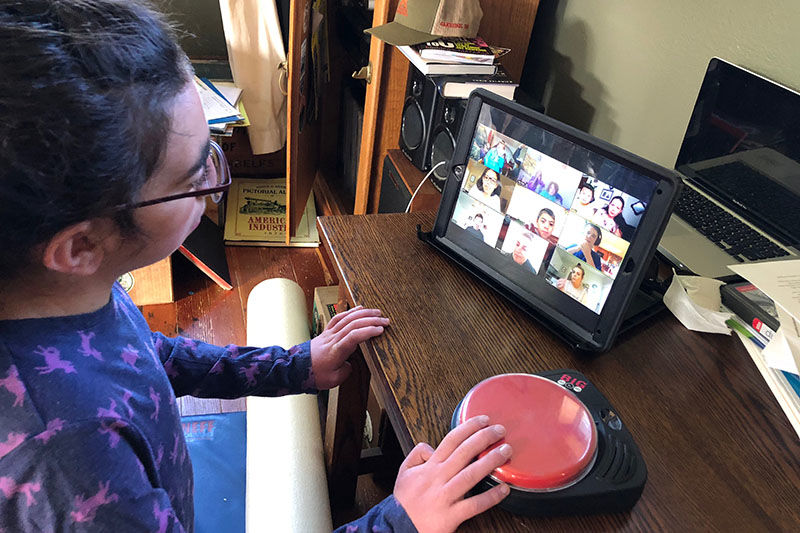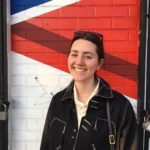Special challenges of special education students under quarantine

Arlie Garrison participates in a Zoom call from a desk at home.
May 29, 2020
The sudden shift to remote learning has pushed Sonoma County’s 40 school districts into unchartered territory, testing already-strained resources. For its nearly 400 special education students, the transition has been especially tough, and the stakes could not be higher, as districts plan for summer and fall sessions.
On a typical school day, many students with physical and intellectual disabilities receive one-on-one, hands-on instruction from a team of specialists according to highly detailed plans called Individualized Education Programs (IEPs). Those lessons are virtually impossible to replicate using videoconferencing tools, such as Zoom, that have become ubiquitous for most students during the shutdown.
Federal law requires that schools provide students with disabilities an education comparable to their peers. In light of school closures during the pandemic, California’s Department of Education has directed districts to achieve this “to the greatest extent possible” in alternative ways. Without clear guidance, parents and teachers across Sonoma County are going to extraordinary lengths to fill in the gaps.
In Sebastopol, Sarah Garrison cares for her 11-year-old daughter Arlie, who is diagnosed with Global Delay and Cerebral Palsy, is visually impaired, has difficulty speaking, gets around using a walker or wheelchair. With Arlie’s school closed, Garrison has taken on a multitude of new roles: occupational therapist, physical therapist, speech therapist, vision therapist and general education teacher.
Despite her best efforts and regular check-ins from Arlie’s teachers, she acknowledged, “It’s a pretty elaborate system that they have at school that you cannot recreate at home.”
Arlie suffers from scoliosis, an abnormal curving of the spine, and her condition could worsen without the daily regimen of stretching and vigorous exercise that a sports trainer and P.E. class provided. Before the shelter-in-place order, Arlie had worked her way up to completing one mile at the Twin Hills Middle School track with her walker. These days, her mother is just trying to keep the scoliosis at bay by having Arlie walk in their neighborhood.
“She’s growing all the time, which means the curve is progressing as she grows,” said Garrison.
For Melissa Staggs, another Sebastopol mother, every day is an impossible juggling act. Her 6-year old son A.J. has Cornelia de Lange syndrome, a genetic disorder that causes developmental delay and other issues. Staggs and her husband own a construction business, and they’ve divided the day into shifts to cover work and home responsibilities, which now include overseeing A.J.’s at-home learning and caring for their 4-year-old daughter Sabrina.
A.J. needs constant supervision and does not communicate verbally, so Staggs or her husband have to facilitate all Zoom lessons with teachers and specialists.
“It’s just a constant blur of one activity to the next to the next,” she said. “As thoughtful and well-put together as these lessons are, it’s still completely overwhelming. I am not a teacher. Or a therapist.”
She added, “There’s no such time for even just changing a load of laundry.”
Staggs has a newfound appreciation for A.J.’s teacher, Katya Robinson, who assembled extensive learning kits for her students each week, until she made a final package to last the end of semester two weeks ago. They include several binders of worksheets and ready-to-make art projects, complete with glitter, glue, paper and pipe cleaners.
“Not only is she creating these lessons, uploading them into Google Classroom, Google Doc-ing us the instructions, but then actually somehow purchasing, packaging and getting us all of the supplies — it’s amazing,” said Staggs.
Robinson, who was Sonoma County’s Teacher of the Year in 2019, is doing her best to keep students motivated online. She can no longer perform a classroom favorite: holding up a stick that says “You’re on FIRE” and having her assistants spray it with a water bottle. But at a recent online lesson, she kicked off “spirit week” with a wacky hairdo.
“I got into teaching, not to teach from a computer,” she said. “I got into it because I love the uniqueness of the kids and the human interaction.”
Robinson isn’t the only teacher going the extra mile.
When the coronavirus shut down Sonoma County schools in March, educator Neal Mckenzie got to work in his two-car garage in Sebastopol.
On top of a workbench and a guitar amplifier, the technology specialist for the county’s Office of Education rigged an embosser to a graphics machine and a 3D printer and began producing braille materials for the county’s visually impaired students who have been forced to learn at home.
Like many educators, Mckenzie worried the hard-fought progress these students made before the pandemic could suffer if they don’t get the individualized instruction and materials they need soon.
“When this whole thing started out, we were like ‘How are we going to do this?’” said Mckenzie. These days, he’s become a one-man print shop, creating custom learning kits for dozens of students and making home deliveries each Friday.
Arlie’s teacher, Mariko Wesley-Fagundes, is also making adjustments to keep each of her 13 students engaged over Zoom. Accustomed to working with three or four students at a time with the help of two aides, she recently asked some students to do jumping jacks while she quizzed another student.
But her biggest struggle is not being in the same room as her students to personally witness their progress.
“What I’m missing everyday is that moment,” she said.
Wesley-Fagundes said any long-term effects of remote learning will depend on each student’s home environment and students’ willingness to allow their parents to stand in as teachers. Even for activities her students have already mastered, she worries “that students will look to their parents and capitulate and say ‘I don’t know how to do this,’” she said.
Less than two months into remote learning, Aine Smalley has already seen signs of regression in her 14-year-old son, Kieran, who has Williams Syndrome, a rare genetic disorder. Smalley has concerns the current crisis will allow schools to lower standards and make temporary accommodations permanent. “We’ve got to give people credit and relax some of our own expectations,” she said. “But it can’t be an excuse to make longer-term shifts in that direction.”
Gov. Gavin Newsom has suggested that schools could re-open with modifications as soon as July — and that’s welcome news for A.J.’s mother.
“I just keep telling myself, there’s got to be an end,” said Staggs. “There’s going to be an end.”


